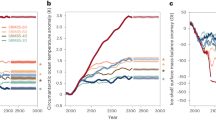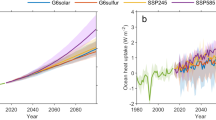Abstract
Geoengineering using solar-radiation management (SRM) is gaining interest as a potential strategy to reduce future climate change impacts1,2,3. Basic physics and past observations suggest that reducing insolation will, on average, cool the Earth. It is uncertain, however, whether SRM can reduce climate change stressors such as sea-level rise or rates of surface air temperature change1,4,5,6. Here we use an Earth system model of intermediate complexity to quantify the possible response of sea levels and surface air temperatures to projected climate forcings7 and SRM strategies. We find that SRM strategies introduce a potentially strong tension between the objectives to reduce (1) the rate of temperature change and (2) sea-level rise. This tension arises primarily because surface air temperatures respond faster to radiative forcings than sea levels. Our results show that the forcing required to stop sea-level rise could cause a rapid cooling with a rate similar to the peak business-as-usual warming rate. Furthermore, termination of SRM was found to produce warming rates up to five times greater than the maximum rates under the business-as-usual CO2 scenario, whereas sea-level rise rates were only 30% higher. Reducing these risks requires a slow phase-out of many decades and thus commits future generations.
This is a preview of subscription content, access via your institution
Access options
Subscribe to this journal
Receive 12 print issues and online access
$209.00 per year
only $17.42 per issue
Buy this article
- Purchase on Springer Link
- Instant access to full article PDF
Prices may be subject to local taxes which are calculated during checkout




Similar content being viewed by others
References
Wigley, T. M. L. A combined mitigation/geoengineering approach to climate stabilization. Science 314, 452–454 (2006).
Robock, A., Oman, L. & Stenchikov, G. L. Regional climate responses to geoengineering with tropical and Arctic SO2 injections. J. Geophys. Res. 113, D16101 (2008).
Crutzen, P. J. Albedo enhancement by stratospheric sulphur injections: A contribution to resolve a policy dilemma? Climatic Change 77, 211–219 (2006).
Jones, A., Haywood, J. & Boucher, O. A comparison of the climate impacts of geoengineering by stratospheric SO2 injection and by brightening of marine stratocumulus cloud. Atmos. Sci. Lett. 12, 176–183 (2011).
Bala, G., Duffy, P. B. & Taylor, K. E. Impact of geoengineering schemes on the global hydrological cycle. Proc. Natl Acad. Sci. USA 105, 7664–7669 (2008).
Goes, M., Tuana, N. & Keller, K. The economics (or lack thereof) of aerosol geoengineering. Climatic Change 109, 719–744 (2011).
Moss, R. H. et al. The next generation of scenarios for climate change research and assessment. Nature 463, 747–756 (2010).
Shepherd, J. et al. Geoengineering the Climate: Science, Governace and Uncertainty (The Royal Society, 2009).
Matthews, H. D. & Caldeira, K. Transient climate-carbon simulations of planetary geoengineering. Proc. Natl Acad. Sci. USA 104, 9949–9954 (2007).
Lunt, D. J., Ridgwell, A., Valdes, P. J. & Seale, A. ‘Sunshade World’: A fully coupled GCM evaluation of the climatic impacts of geoengineering. Geophys. Res. Lett. 35, L12710 (2008).
Latham, J. et al. Global temperature stabilization via controlled albedo enhancement of low-level maritime clouds. Phil. Trans. R. Soc. A 366, 3969–3987 (2008).
Ricke, K. L., Morgan, M. G. & Allen, M. R. Regional climate response to solar-radiation management. Nature Geosci. 3, 537–541 (2010).
Moore, J. C., Jevrejeva, S. & Grinsted, A. Efficacy of geoengineering to limit twenty first century sea-level rise. Proc. Natl Acad. Sci. USA 107, 15699–15703 (2010).
Barrett, S. The incredible economics of geoengineering. Environ. Res. Econom. 39, 45–54 (2008).
Moreno-Cruz, J. B., Ricke, K. L. & Keith, D. W. A simple model to account for regional inequalities in the effectiveness of solar radiation management. Climatic Change http://dx.doi.org10.1007/s10584-011-0103-z (2011).
Schelling, T. C. The economic diplomacy of geoengineering. Climatic Change 33, 303–307 (1996).
Millard-Ball, A. The Tuvalu Syndrome Can Geoengineering solve climate’s collective action problem? Climate Change http://dx.doi.org/10.1007/s10584-10011-10102-10580 (2011).
Lempert, R. J., Schlesinger, M. E., Bankes, S. C. & Andronova, N. G. The impacts of climate variability on near-term policy choices and the value of information. Climatic Change 45, 129–161 (2000).
van Dantzig, D. Economic decision problems for flood prevention. Econometrica 24, 276–287 (1956).
Meehl, G. A. et al. in IPCC Climate Change 2007: The Physical Science Basis (eds Solomon, S. et al.) (Cambridge Univ. Press, 2007).
Weaver, A. J. et al. The UVic Earth System Climate Model: Model description, climatology, and applications to past, present and future climates. Atmos.-Ocean 39, 361–428 (2001).
Goes, M. et al. What is the skill of different ocean tracers in reducing uncertainties about projections of the Atlantic Meridional Overturning Circulation. J. Geophys. Res. 115, C12006.
Lenton, T. M. & Vaughan, N. E. The radiative forcing potential of different climate geoengineering options. Atmos. Chem. Phys. 9, 5539–5561 (2009).
Yohe, G. W. Uncertainty, short-term hedging and the tolerable window approach. Glob. Environ. Change Human Policy Dim. 7, 303–315 (1997).
Jevrejeva, S., Grinsted, A., Moore, J. C. & Holgate, S. Nonlinear trends and multiyear cycles in sea level records. J. Geophys. Res. 111, C09012 (2006).
Brohan, P., Kennedy, J. J., Harris, I., Tett, S. F. B. & Jones, P. D. Uncertainty estimates in regional and global observed temperature changes: A new data set from 1850. J. Geophys. Res. 111, D12106 (2006).
Acknowledgements
This study was partially supported by the World University Network, the Penn State Center for Climate Risk Management, and the Center for Climate and Energy Decision Making (SES-0949710, through a cooperative agreement between the National Science Foundation and Carnegie Mellon University). P.J.I. acknowledges support from a Natural Environment Research Council PhD studentship. Any opinions, findings, and conclusions or recommendations expressed in this material are those of the authors and do not necessarily reflect the views of the funding entities.
Author information
Authors and Affiliations
Contributions
All authors jointly designed the study and wrote the paper. P.J.I. performed the model simulations and data analyses.
Corresponding author
Ethics declarations
Competing interests
The authors declare no competing financial interests.
Supplementary information
Rights and permissions
About this article
Cite this article
Irvine, P., Sriver, R. & Keller, K. Tension between reducing sea-level rise and global warming through solar-radiation management. Nature Clim Change 2, 97–100 (2012). https://doi.org/10.1038/nclimate1351
Received:
Accepted:
Published:
Issue Date:
DOI: https://doi.org/10.1038/nclimate1351
This article is cited by
-
Satellite imaging reveals increased proportion of population exposed to floods
Nature (2021)
-
Potential implications of solar radiation modification for achievement of the Sustainable Development Goals
Mitigation and Adaptation Strategies for Global Change (2021)
-
Uncertainty and the basis for confidence in solar geoengineering research
Nature Reviews Earth & Environment (2020)
-
Halving warming with idealized solar geoengineering moderates key climate hazards
Nature Climate Change (2019)
-
Climate experts’ views on geoengineering depend on their beliefs about climate change impacts
Nature Climate Change (2019)



